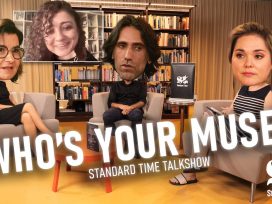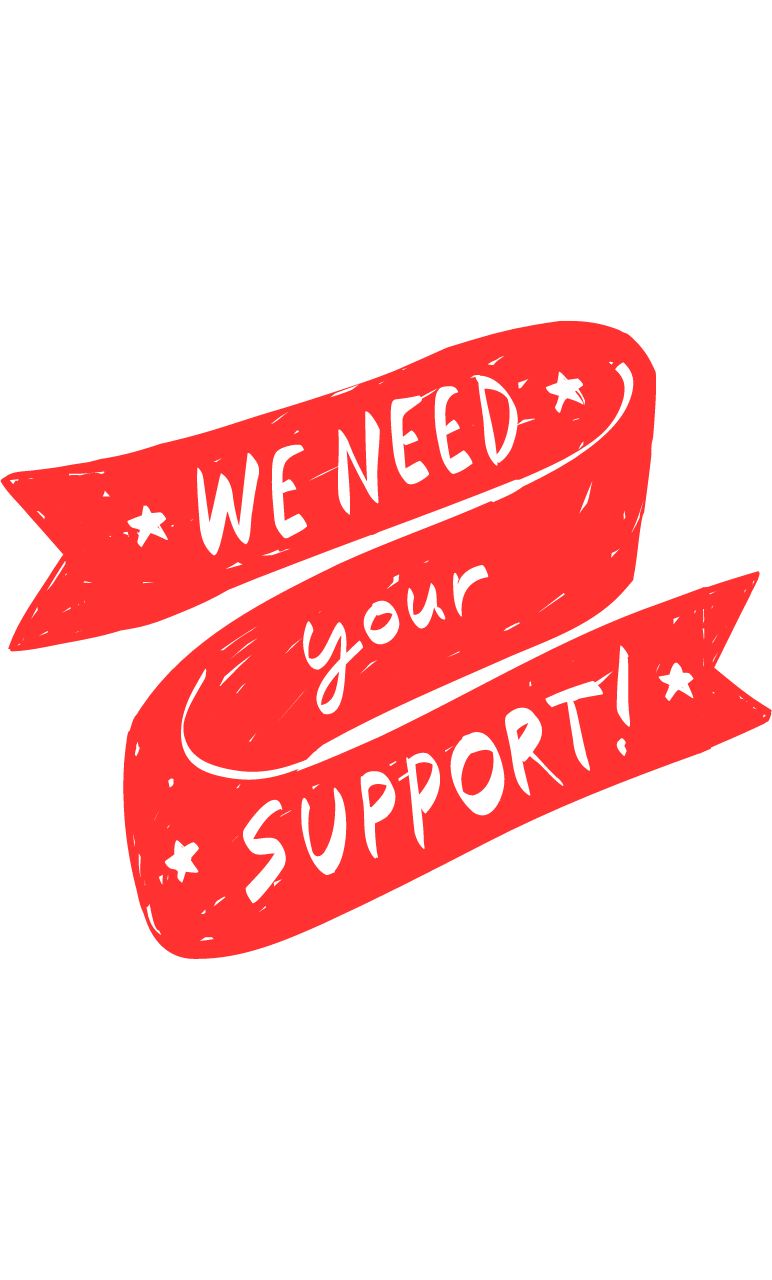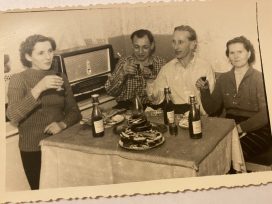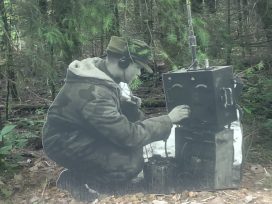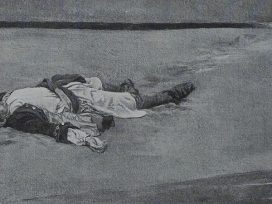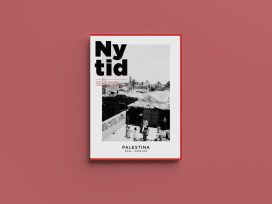The Boss said:
jump to it, lads
the boys with their rosy faces
groaned
they creaked
on their little wooden legs.
Tadeusz Różewicz, ‘Right Away, Boss’
A game of knucklebones
In the beginning, let us consider not the Word but the Image. It’s what the subject demands. What’s more there are many images to choose from – far too many. Depictions of mutilated, fragmented bodies with missing limbs, raw flesh bearing the irreducible traces of that ‘meat grinder’: war. The images tend to be evocations of human cannon fodder – though the bodies of non-human animals, which are so seldom remembered, fell between the grinder’s blades no less often.
War is metamorphosis twice over. The Word was made flesh, and slaughtered flesh became carrion. War is butchery. It is a time when human bodies are torn apart, their interiors exposed as shells and shrapnel do their work, dispassionately blurring the difference between animal and human. Flying bullets are indifferent to the tissue they encounter.
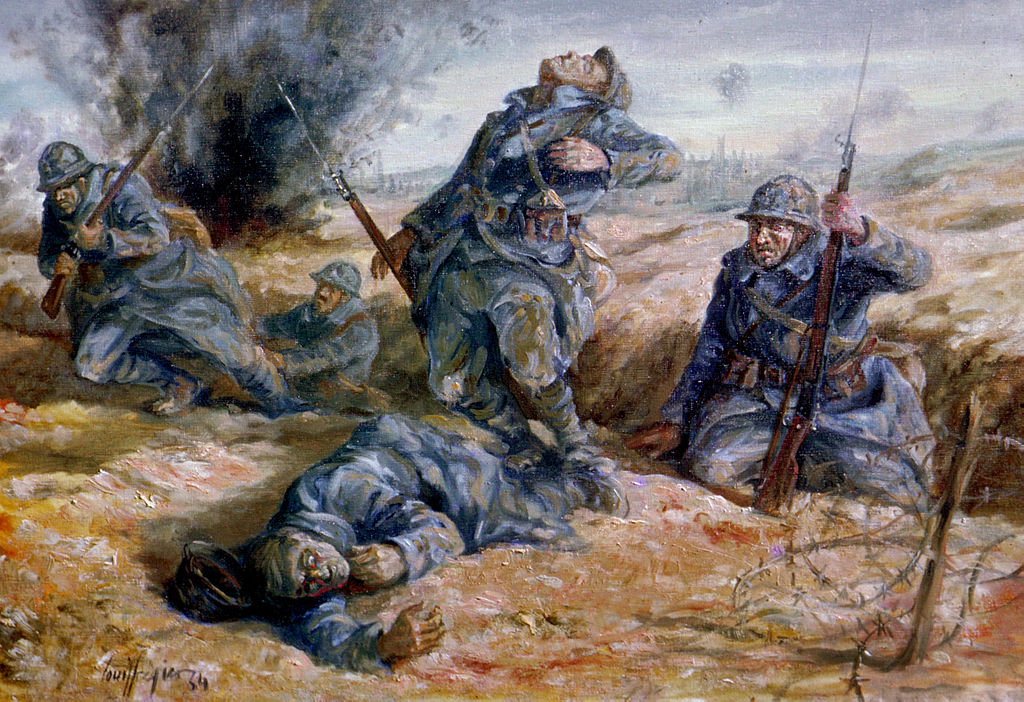
Louis Frégier, ‘Le bond, huile sur toile (Mémorial de Verdun)’, 1967. Photo via Wikimedia Commons.
In art or literature, it’s not uncommon for human and animal bodies to be shown as equally balanced on the scales of war. As Maria Janion writes, in expressionist painting ‘war – shown as a gigantic slaughterhouse – blatantly revealed its monstrosity. Stripping people of what was human, it made them a herd of cattle destined for slaughter’. In the context of the brief life-span most likely anticipated by a soldier advancing in the battle of the Somme or Verdun, it may have been easier to see the resemblance between military recruits (never mind their style of uniform or helmet) and a herd of animals disappearing forever behind the walls of a slaughterhouse. In other circumstances the kinship between the two generally escapes us.
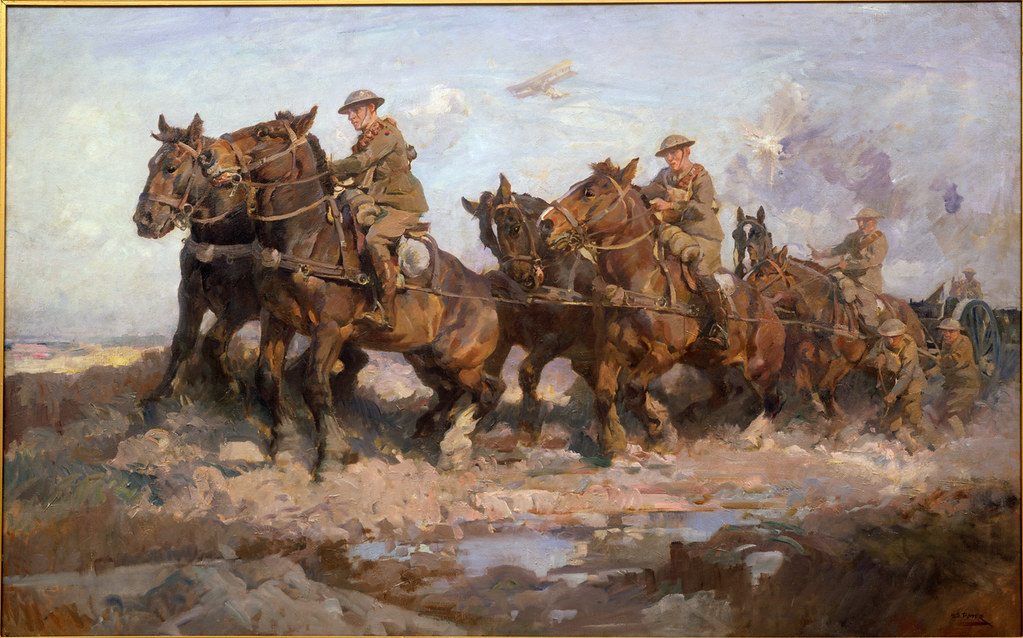
Harold Septimus Power, ‘Bringing up the guns’ (oil on canvas, 1917). Photo via Archives New Zealand on Flickr.
There are many artistic and literary works in which the fortunes of animals and humans intersect against the backdrop of war. A fat volume could be devoted to the wholesale slaughter of that multimillion-strong army of hooved and shod comrades-in-arms – horses, donkeys and mules. Other animals unassociated with warcraft also suffered and died, of course. In Eugeniusz Małaczewski’s The horse on the hill, the piercing cry of a Percheron horse skinned alive, is one of the most suggestive ‘apocalyptic symbols of war’ in Polish literature.As a cultural image, it gravitates between the agony of horses described by Stefan Żeromski in Ravens and Crows Will Peck Us to Pieces and Pablo Picasso’s Guernica. While remaining potent as allegory, it also says a lot about the real suffering of animals in war.
Another view of war as that insatiable meat grinder can be found in the work of contemporary performance artist Marina Abramović. Her installation ‘Balkan Baroque’, for example, cannot be fully or adequately described in words. It has to be seen.
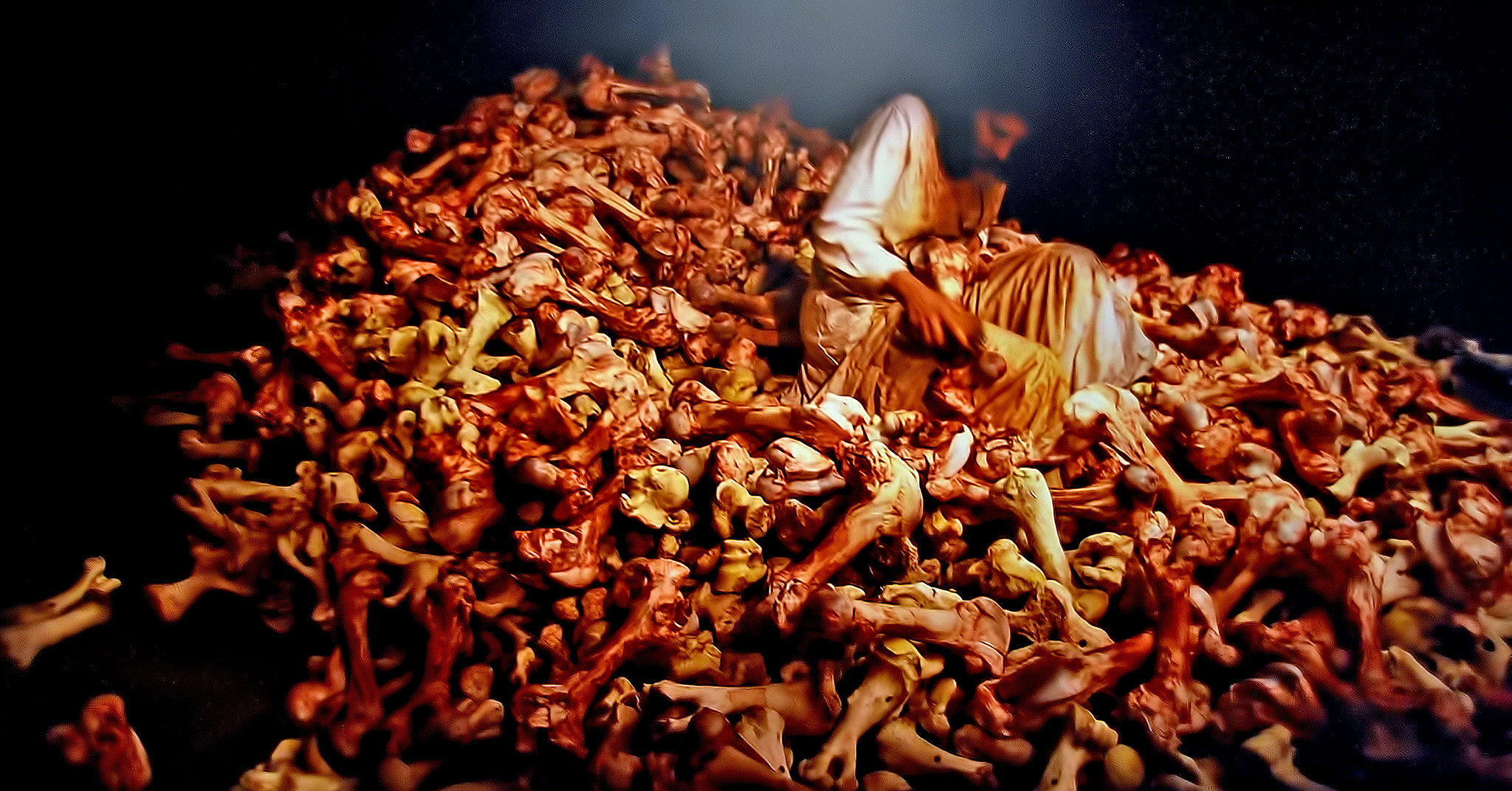
Photo of a Cibachrome photograph of Marina Abramović’s 1997 performance, ‘Balkan Baroque’. Courtesy of the artist and Sean Kelly Gallery. Image via Choo Yut Shing from Flickr.
The interior of a dark room, with a bloodied mound emerging slowly in the centre. It is a pyramid of bones, with decaying meat, tendons and muscle fibres still attached. In the middle of this ‘reeking’ heap, sits a female figure in a long white dress, now irreversibly losing its whiteness. One by one, she grasps the bones in her bare hands, attempting to remove the remnants of muscular tissue and humming Balkan songs as she does so. Illuminated by a beam of chiaroscuro, the scene has a ‘risky aesthetics’ quality, which makes it hard to look away. The thighbones lying in the foreground very recently belonged to cows. They had formed part of their pulsating bodies. But a viewer, harshly tutored in the school of twentieth century genocide cannot but associate them with similarly bloodied heaps and mounds in Turkey, the Nazi concentration camps, Cambodian Killing Fields, Rwanda, or Abramović’s own homeland, Serbia.
Prosthetics and irony
This section of my ‘essay on war’ will likewise focus on flesh dressed up in uniform, especially that of soldiers who survived battle, yet failed to escape in one piece. There is a sense, of course, in which nobody who has seen military action escapes in one piece. Consider the victims of shell shock in World War I, spared any visible anatomical damage. But among the countless victims of armed conflict, there is a huge group maimed in a far more literal sense, those treated as the live ‘waste’ of war. I dedicate my reflections to them. Let me focus, however, on a few cultural representations of the havoc modern warfare can wreak on the human body.
These portrayals raise a number of questions. How do we find a language to discuss the incurability of a wound without exposing ourselves to charges of wounding? How can we prevent our gaze from becoming yet another tool of violence? Magdalena Zdrodowska has written about the ambivalence of visual contact between people with disabilities and those without:
Interpreting disability as an oddity, an aberration or a transgression, translates into rubbernecking and a gaze from which people with disabilities cannot escape. The glances of passers-by may be involuntary and hidden, or else ostentatious and offensive. Either way, they are forms of social oppression and stigmatization often mentioned by disabled people, if they are given a voice and the opportunity to talk about their experiences.
The humanities – especially literature, visual art and theatre – traditionally help to break down social barriers that hamper empathetic understanding between people. All three can prompt discourses that liberate, emancipate and contribute to the transformation of social consciousness. The numerous cultural representations of disability, and war disablement in particular, indicate that the arts are going some way towards doing their job. As J.M. Coetzee said: ‘there is no limit to the extent to which we can think ourselves into the being of another’.
But in all the works mentioned so far, and in Zdrodowska’s remarks quoted above, there is a palpable flaw that affects how the experience of physical disability is perceived. It lies in the difference between looking in from outside (which can often mean unempathetic ‘staring’) and trying to reconstruct an internal point of view, by giving a voice to the very people those who struggle with ‘social oppression and stigmatization’. The genre in which their voice is communicated may have to be fictional, for all kinds of reasons, but the need for more research into the real experience of disability in Poland – whether reported biographically or autobiographically – has been highlighted by Wojciech Śmieja.
One fascinating insight into movement around this impassable border can be found in a poem by Tadeusz Różewicz entitled ‘Right Away, Boss’. An excerpt appears at the beginning of this article.Seven decades have passed since the poem was written, yet its inventiveness in telling the story of post-war disability continues to astonish. Even more striking is the poet’s use of irony, a literary technique that seems to exclude the possibility of balanced conversation. It creeps in between those invisible inverted commas characteristic of Różewicz’s poetry, and is there in the sustained tension between a mood that is sober and unsmiling, and language that is ostensibly bantering or mocking. Ironic ambiguity undoubtedly complicates the modality of the poem – especially as the author avoids unnecessary commentary – but equally, much as in social satire, Różewicz’s tone expands the moral dimensions of his work. It sensitizes readers to the fortunes of war veterans who returned home to a country ruled by a new socialist regime, and exposes the growing gap between people’s experience of daily life and communist press propaganda. Lucyna Ratkowska, a researcher into the periodicals of the time, also makes the following point:
In the post-war press, only people who had become disabled as a result of active service during World War II were favourably described. Theirs was a kind of acquired disability, the result of valour, heroism and participation in fighting for a greater cause. Former soldiers, injured while fighting occupying forces, were depicted as people towards whom society had specific obligations: ‘in the event of injury, they would treat him with care, in disability they would ensure his relative prosperity, and in the event of death, they would not allow his family to fall into penury’.
In the arts of the interwar period, there is further evidence that irony, of the kind favoured by Różewicz, was regarded as a tool that could serve to access public attention. Its use in some artworks highlights the real effects of combat that grandiose speeches by politicians or generals widely ignored. One piece I have in mind bears the title War rejuvenates a man’s body (Marinetti) a photomontage. It was created in 1936 by Mieczysław Berman, an artist and graphic designer who later gained widespread recognition under the communist regime.
Conceptually, the work is relatively simple. It plays with a multiplicity of contrasts: between word and image, the title and the accompanying photomontage and, finally, between the two sections of the title. The quotation that constitutes the title’s main part demands inverted commas (although that would not have been the intention of the instigator of the phrase) and reveals its ambiguity when the author’s name appears in brackets. He is Filippo Tommaso Marinetti, an eminent Italian poet and publisher, known primarily as the founder of futurism. He was, nevertheless, a man also fascinated by fascism and the figure of Benito Mussolini. As a distinguished writer, and prominent fascist politician, Marinetti visited Poland in March 1933. It may be that Berman’s photomontage was directly influenced by this visit, which provoked unprecedented resonances in Polish cultural and political life.
There was, however, a further impulse that contributed to the creation of this work. The years between Marinetti’s Polish tour and the production of Berman’s photomontage saw the outbreak of the Second Italo-Ethiopian War (1935-1936). For pacifists, left-wingers, and potential communists – of whom Berman was one – this was another sign of impending apocalypse. Events on the African front proved a ‘trial by fire’ for Berman. In response, he later subjected parts of his futuristic manifestos celebrating war as ‘the sole hygiene of the world’ to ironic decontextualization.
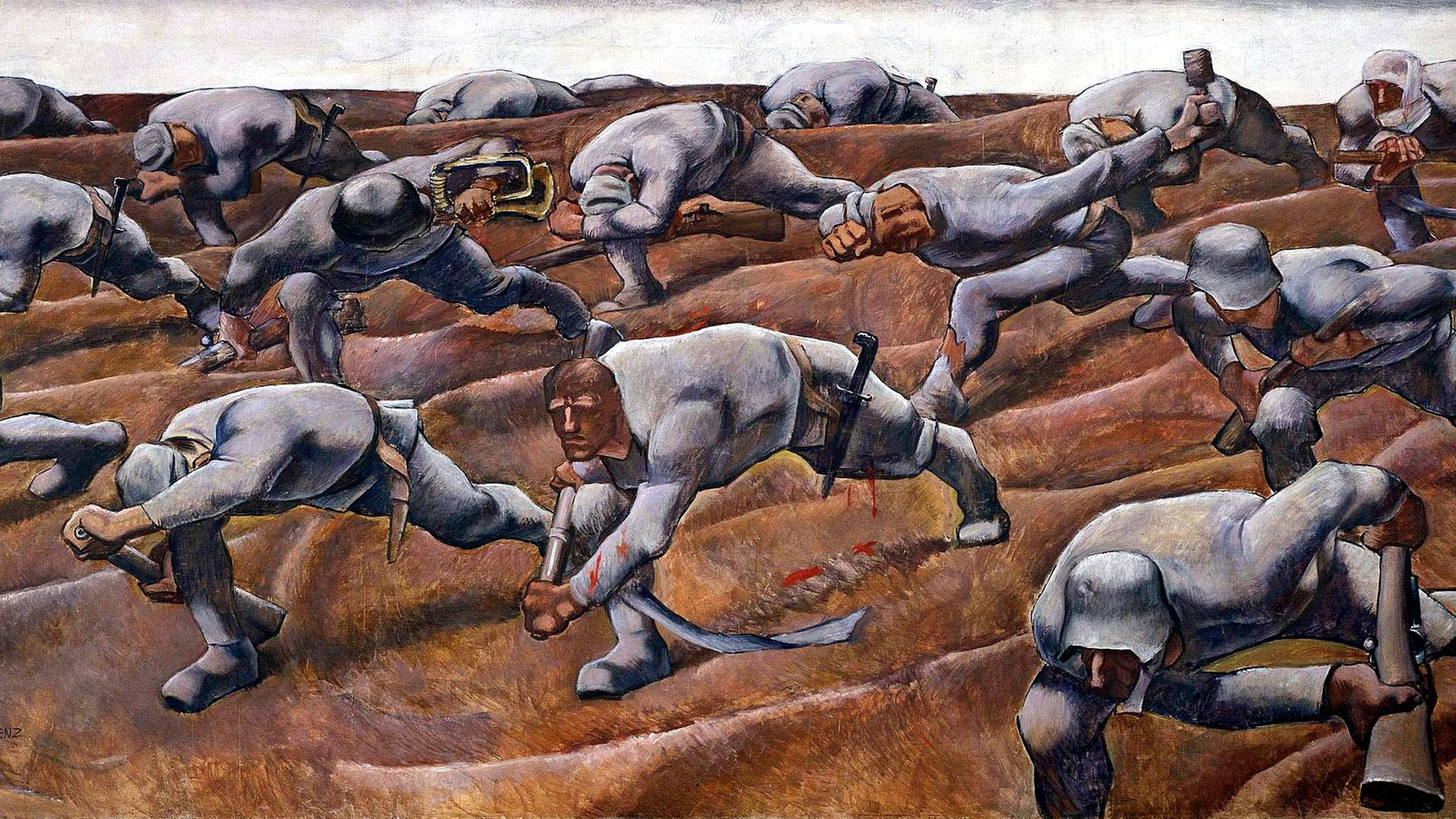
Albin Egger-Lienz, ‘The nameless’ (‘Den Namenlosen’, tempera, 1916) / Public domain Photo via Pappenheim from Wikimedia Commons.
The taste of ants
My next selected text is a novel. I read it many years ago as a boy, when it featured as part of the obligatory, communist literary canon. Just as ideological tensions later affected the reception of Marinetti’s works, so propaganda played its part here as well.
Reading leaves a trail and a taste. My own early literary experiences evoke the taste of ants – the bodies of insects dug up from under the snow, which left ‘on the dry, cracked tongue the spicy and pungent taste of formic acid’. Years on, I have found myself re-reading Boris Polevoy’s novel, Story of a real man with this essay in mind. And again, it tasted pungent, bitter even, but for very different reasons. Sentimental journeys through literature often induce feelings of disbelief and ambivalence, alongside surprise that a crudely structured narrative was all it once took to seduce a young reader’s imagination. This may be the measure of literary success, of course. A sensible balance between the ‘masculine adventure narrative’ and a dose of propaganda-fuelled socialist realist didacticism meant that Polevoy could – in the context of my boyhood – compete with Jules Verne, Mark Twain, or any of the classics of Polish young adult literature. It is worth a mention that the heroes of another example of this genre – ‘The book of brats’ by Edmund Niziurski – are on the edge of their seats as they watch the film version of Story of a real man.
As a young reader, I too identified deeply with Polevoy’s hero. Today that feeling is long gone, but I’d nevertheless like to explore why, after so many years, Story of a real man remains of interest. The key, I would argue, lies in the way the maimed body of the main character – fighter pilot Aleksey Meresyev – is perceived. The novel begins with a robust description of an air battle on the Eastern Front, when a plane marked with a red star is shot down. Amazingly the pilot, Meresyev, escapes with his life (‘As it fell, the plane clipped the tops of the pine trees. This softened the impact’). Nonetheless, he is severely injured and loses the use of both legs. Though lost in the middle of a forested wilderness and unable to walk, after eighteen days he manages to reach a human settlement where he is cared for and, most important of all, able to contact his parent unit. After that he is speedily evacuated to a Moscow hospital.
The most important element in the first part of the novel, from the point of view of this analysis, is the broken body of the hero: his laborious, lonely trek as he crawls and rolls his way to safety. Not even the most serious mutilation will exempt a Red Army soldier from their oath. Driven by unwavering willpower, a desire for revenge, and faithfulness to his pledge, Meresyev’s body moves unwaveringly in a direction both safe and symbolic: propelled eastward by biological instinct. His forest odyssey is relentlessly gripping and, in many ways, reminiscent of the story of a castaway on a wooded, snow-covered desert island. He feeds on berries, herbs and ants. On one occasion, he manages to hunt a hedgehog. But above all, he is constantly struggling with the burden of a damaged body that must be lifted up and carried. To overcome his own gravitational weight, the pilot cuts down a young pine and makes a stick, with a fork at the top to support his chin and so help shift the bulk of a torso and limbs that refuse to obey. The trail he leaves in the forest snow is like a track left by a wounded animal.
Where nothing is politically neutral, injury too is subject to ideological evaluation. My purpose here is to examine how disability, and war disablement in particular, resonates in a work framed by Soviet ideology and the poetics of socialist-realism. The fact that Polevoy’s chief protagonist is a soldier, permanently disabled as a result of active service against the Nazi aggressor, could be considered a violation of the literary rules of the time. Socialist realism demanded an explicit and hortatory moral message. The war invalid, whatever his erstwhile role in the Great Patriotic War, was not seen as suitable subject for a commemorative monument. In order to be recognized, the disabled veteran had to make a superhuman effort of will to overcome his failing body and once again prove his usefulness to Soviet society. This is what Lieutenant Meresyev does, and the second part of Polevoy’s narrative follows the familiar shape of Nikolai Ostrovsky’s classic socialist realist novel How steel was tempered.
Before this, however, the pilot has to confront the harsh reality of losing his limbs. Doctors in the Moscow clinic diagnose frostbite with progressive gangrene, and both his legs are amputated at shin level. A ‘dull tapping in the enamel bucket’cuts into the plot like a scalpel but, of course, that’s not the end of the story. Though initially plunged into apathy, Meresyev regains faith in life when he reads a newspaper cutting passed to him by a fellow patient. It contains an article about Lieutenant Valerian Karpovich, a Russian pilot wounded in World War I. Karpovich’s foot was amputated as a result of his injuries but, instead of retiring from military service, he designed his own prosthetic limb, persisted in taking exercise, and was eventually able to return to the air force. (This part of the novel was inspired by the biography of Aleksander Prokofiev de Seversky, the aviation ace of the Russian Empire).
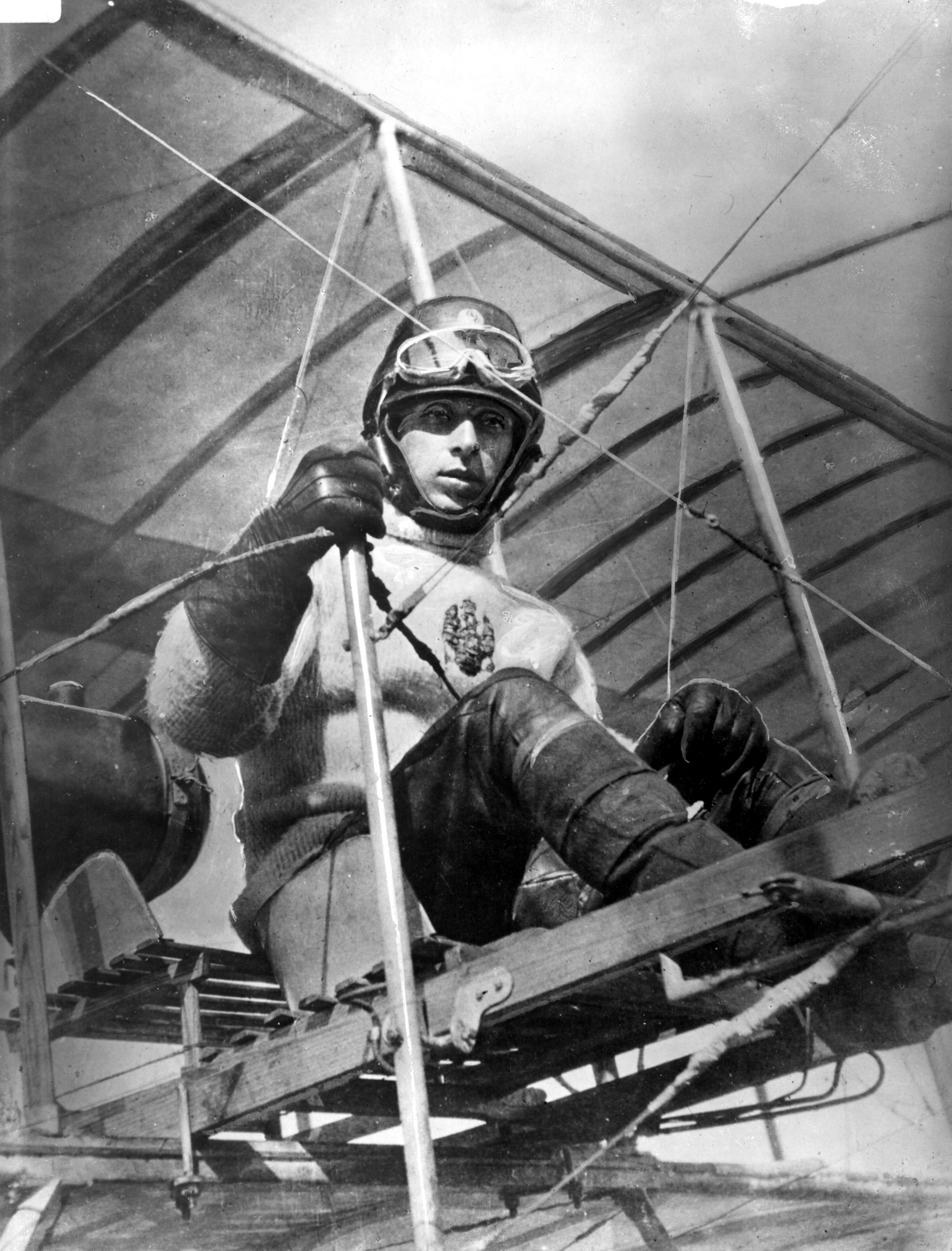
Major Alexander Procofieff de Seversky sits at the controls of an early aircraft, circa 1914. Photo is Russian public domain, via Wikipedia.
The direction Meresyev’s life takes at this point in the narrative is predictable enough. He overcomes his physical limitations, as well as the scepticism of other patients and doctors. Equipped with prosthetic legs that, though imperfect, are nonetheless reassuringly Soviet, Meresyev is soon back in the cockpit, ready to take on the enemy.
An afterword on prosthetics
This is where Story of a real man ends, but there is a real-life postscript to Polevoy’s narrative. It does not make a comfortable reading. What happened to Soviet veterans maimed in action during the Second World War is one of the most shameful episodes in the history of the USSR.
Consider some statistics. Data provided by the Military-Medical Museum in St Petersburg suggests that 46.25 million Soviet citizens were wounded during World War II. Over 10 million returned home with permanent disabilities. Among them were 775,000 people with skull injuries; 155,000 who lost one eye; 54,000 who were blinded; 3 million who lost an arm; 1.1 million who lost both; 3.25 million who lost a leg; 1.12 million who lost both legs; and almost 90,000 who lost all four limbs. In Soviet Russia, the last group were referred to, hideously, as ‘samovars’. One war veteran, with no arms or legs, is portrayed by the Russian artist Gennady Dobrov in a drawing entitled The Unknown Soldier.
Dobrov’s art is disturbing in many respects, but the environment in which he worked is quite as important as the subjects he depicts. Dobrov was one of the few witnesses permitted to enter a home for war veterans located in a former monastery on the small island of Valaam, on Lake Ladoga. This was founded in 1950 and named the ‘House of War and Work Invalids’. Reports about life in the sanatorium are scant. They suggest, nevertheless, that inmates were left to vegetate in conditions comparable to those depicted by Alexander Solzhenitsyn in the Gulag Archipelago. This ‘home’ was one of several places – well hidden from other Soviet citizens – where disabled veterans, deprived of any role in the communist public space, were deported from 1948 onwards. Many of these people were destitute, yet the authorities persisted in accusing them of vagrancy, begging, hooliganism or alcoholism. Among former soldiers, rounded up by militia and security patrols, were some who had been decorated with the Gold Star medal awarded to Heroes of the Soviet Union. It is entirely possible that any pilot with a proud history similar to Senior Lieutenant Meresyev’s, would have ended up in a facility of this kind.
